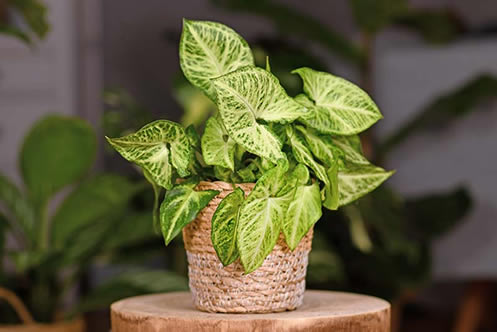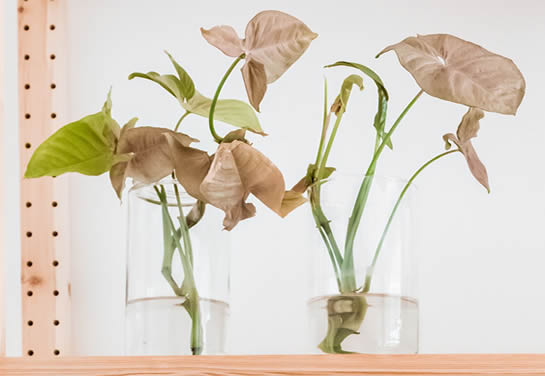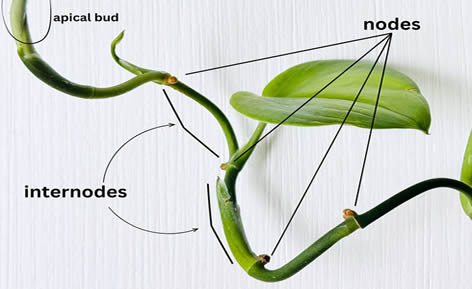Syngoniums are fast growers and even faster rooters, making them a dream to propagate. Whether you’re snipping a vine to encourage bushier growth, rescuing a leggy stem, or just multiplying your favorite variety, Syngonium propagation is one of the easiest—and most rewarding—projects for plant lovers.
Here’s exactly how to do it, step by step.
Table of Contents
- Syngonium podophyllum
- Popular Syngonium Varieties to Propagate
- Best Time to Propagate: Spring Through Early Fall
- Water Propagation: Fast and Fun to Watch
- Soil Propagation: Skip the Jar and Go Straight to the Pot
- Propagation in Pots: Plant Multiple Cuttings for a Fuller Look
- Division: Works Well for Mature Plants
- Outdoor Propagation: Ideal in Warm, Humid Conditions
- Caring for New Plants: Gentle Light and Moisture
- Final Thoughts
Syngonium podophyllum
Syngonium podophyllum is a tropical trailing plant native to the rainforests of Central and South America.
In its natural environment, it climbs trees using aerial roots and changes shape as it matures—starting with classic arrow-shaped leaves and developing lobed forms over time.

This fast-growing member of the Araceae family is commonly known as Arrowhead Plant or Goosefoot, and it comes in a huge range of colors—from deep green and creamy white to pale pink and bright neon.
Thanks to its climbing habit and rapid growth, Syngonium is one of the easiest houseplants to propagate at home.
Popular Syngonium Varieties to Propagate
Each Syngonium variety has a distinct personality—and all of them can be propagated using the same techniques.
Here are a few favorites you might want to expand:
• Three Kings – Known for its creamy marbled leaves with soft green edges. Each leaf is uniquely patterned.
• Albo – A highly variegated white and green form with unpredictable splashes across every leaf.
• Neon Robusta – A vibrant pink cultivar with a shimmering blush hue that softens as it matures.
• Pixie and Mini Pixie – Small-leaved, compact versions ideal for small spaces or grouped arrangements.
• Pink Allusion – One of the most popular pink types, with green edges and rosy interiors.
• White Butterfly – Pale green leaves with creamy white centers that resemble butterfly wings.
• Berry Allusion – Subtle pink veins run through pale green foliage, giving it a soft, romantic tone.
• Confetti – Pale green leaves flecked with delicate pink speckles, perfect for collectors.
You can propagate any of these using the methods below—each will root and grow with the same ease as standard green types.
Best Time to Propagate: Spring Through Early Fall
Propagate Syngonium during the warmer months when the plant is actively growing.

The cuttings root quickly and recover faster in bright, warm, and humid conditions.
Water Propagation: Fast and Fun to Watch
Take a cutting that includes at least one leaf and one visible node.
The node is where the roots will grow, so it must be submerged in water.
Remove any leaves that would sit below the water line.
Place your cutting in a jar of clean water and set it somewhere bright but out of direct sunlight.
Change the water every few days to keep it fresh.
Bonus Tip: Add a drop or two of a balanced liquid fertilizer (such as 10-10-10 like this one) diluted to one-tenth strength to the water.
This gentle feeding can help support root development without stressing the cutting.
Roots will begin forming within a week or two. Once they’re about 2 inches long, transplant the cutting into soil.
Soil Propagation: Skip the Jar and Go Straight to the Pot
You can also plant your Syngonium cutting directly into moist soil.
Choose a small pot with good drainage and fill it with a light, well-aerated mix—potting soil with perlite and coco coir works well.
Dip the cut end in rooting hormone (optional), plant it with the node just below the surface, and water lightly.

Covering the pot with a clear plastic bag can help trap humidity and speed up root formation.
Keep the pot in bright, indirect light, and open the plastic occasionally to let air in.
Once new growth appears, remove the covering and treat it like a mature plant.
Propagation in Pots: Plant Multiple Cuttings for a Fuller Look
Want a bushier plant from the start?
Take several Syngonium cuttings and plant them together in the same pot.
Space them evenly around the edge of the pot and root them directly in soil.
As they grow, they’ll fill in the container with lush, dense foliage.
This method is perfect if you want a fuller tabletop plant rather than a single trailing vine.
Division: Works Well for Mature Plants
If your Syngonium has grown into a dense cluster, you can divide the root ball during repotting.
Gently separate the root mass into two or more sections, making sure each piece has roots and healthy foliage.
Repot the divisions in fresh soil and water thoroughly.
This method is fast, reliable, and gives you instant new plants with minimal effort.
Outdoor Propagation: Ideal in Warm, Humid Conditions
If you live in USDA zones 10–11, you can propagate Syngonium outdoors during the growing season.

Place your water or soil cuttings in a shady, humid spot like a covered porch or greenhouse bench.
In cooler zones, it’s best to propagate indoors and only move new plants outside once nighttime temperatures are consistently above 60°F.
Make sure they stay in dappled light and out of direct sun.
Caring for New Plants: Gentle Light and Moisture
Newly rooted Syngoniums need bright, indirect light and consistent moisture.
Keep the soil lightly damp but not soggy, and increase humidity if leaves start to curl or dry out.
Hold off on fertilizing until new growth appears, then feed with a diluted liquid fertilizer every 4–6 weeks during the growing season.
For more detailed care instructions read our article Arrowhead Plant Care: How to Grow Colorful, Fast-Growing Syngonium Indoors and Out.
Final Thoughts
Propagating Syngonium is a satisfying way to grow your collection, gift cuttings to friends, or simply rejuvenate a trailing vine.
With a clean cut, a little humidity, and a splash of patience, you’ll have new baby Arrowheads ready to pot up or trail in no time.

